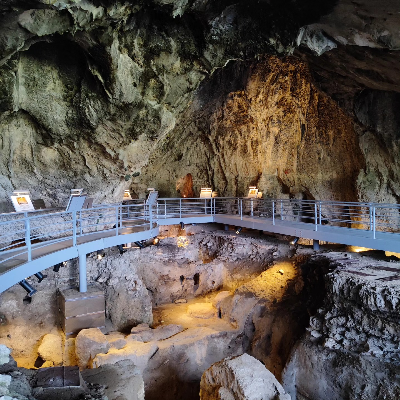
©
Після тривалих реставраційних робіт печера Теопетри, розташована в регіоні Трикала у Фессалії, офіційно знову відкрита для відвідувачів. Її повторне відкриття знаменує завершення складного проєкту з консервації, що реалізовувався в межах Регіональної операційної програми Фессалії 2014–2020 за підтримки як європейських, так і національних джерел фінансування. Печера Теопетри вважається однією з найважливіших доісторичних стоянок у Греції, що надає унікальні відомості про ранню присутність людини в регіоні. Розташована на межі між родючою Фессалійською рівниною та гірською системою Пінд, вона демонструє особливе поєднання природних умов, що знайшло відображення у стратиграфії та культурних нашаруваннях печери. Загальна площа пам’ятки становить близько 500 квадратних метрів, а широка аркова брама дозволяє природному світлу щедро проникати всередину. З печери відкривається вражаючий краєвид на скелі та монастирі Метеори. Раніше об’єкт був закритий через серйозні технічні й безпекові виклики: археологи, інженери, біологи та працівники Управління палеоантропології та спелеології провели ретельну роботу зі стабілізації та збереження пам’ятки. Їхня професійність забезпечила не нові можливості для досліджень цього виняткового об’єкта, який продовжує проливати світло на доісторичне минуле Південно-Східної Європи.
Theopetra Cave Reopens to Researchers and Visitors
Following a prolonged period of restoration, Theopetra Cave, located in the Trikala region of Thessaly, has officially reopened to the public. Its reopening marks the completion of a complex conservation project carried out under the Thessaly Regional Operational Programme 2014–2020, supported by both European and national funding sources. Theopetra Cave is regarded as one of the most significant prehistoric sites in Greece, offering invaluable insights into early human presence in the region. Situated at the transition between the fertile Thessalian plain and the mountainous terrain of the Pindus range, the site reflects a unique blend of natural environments, visible in the cave’s stratigraphy and cultural layers. Covering an area of approximately 500 square metres, the cave features a wide arched entrance that allows abundant natural light to flood the interior. From within, visitors enjoy breathtaking views of the Meteora rock formations and monasteries. The site had previously been closed due to substantial technical and safety concerns. Archaeologists, engineers, biologists, and staff from the Department of Palaeoanthropology and Speleology undertook meticulous work to stabilise and preserve the monument. Their expertise has not only safeguarded the site’s integrity but also enabled new opportunities for research at this extraordinary location, which continues to shed light on the prehistoric past of Southeastern Europe.
1021